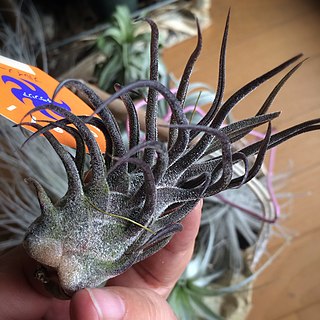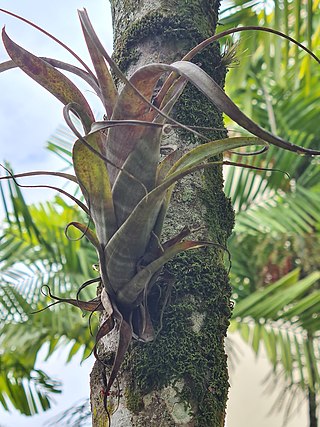
Catopsis sessiliflora is a species in the genus Catopsis. This species is native to West Indies, and also to Latin America from Puebla and Jalisco south to Peru.

Pitcairnia lanuginosa is a species of flowering plant in the family Bromeliaceae. This species is native to Bolivia and Brazil.
Racinaea spiculosa is a species of flowering plant in the family Bromeliaceae. This species is native to Bolivia, Brazil, Costa Rica, Venezuela and Ecuador.

Tillandsia lorentziana is a species of flowering plant in the family Bromeliaceae. This species is native to Bolivia and Brazil.

Tillandsia paraensis is a species of flowering plant in the genus Tillandsia. This species is native to Bolivia, Peru, Ecuador, Colombia, the Guianas, Brazil and Venezuela.

Tillandsia polystachia is a species of flowering plant in the genus Tillandsia. This species is native to Central America, the West Indies, Bolivia, Colombia, Brazil, Ecuador, Mexico and Venezuela.

Tillandsia pruinosa, is a species of flowering plant in the family Bromeliaceae. It is commonly known as the fuzzywuzzy airplant. This species is native to northern South America, Central America, southern Mexico, the West Indies and Florida.

Tillandsia streptocarpa is a species of flowering plant in the Bromeliaceae family. This species is native to Bolivia, Peru, Argentina, Paraguay, and Brazil.

Tillandsia tenuifolia, the narrowleaf airplant, is a species in the genus Tillandsia. This species is widespread across much of South America and the Caribbean islands.

Tillandsia flexuosa, the twisted airplant, is a species of bromeliad in the genus Tillandsia. This species is native to Central America, southeastern Mexico, northern South America and the United States (Florida).

Tillandsia schiedeana is a species of flowering plant in the genus Tillandsia. It was named for the collector Christian Julius Wilhelm Schiede. As an epiphyte, it is found "growing in open tropical forests, and saxicolous, growing on cacti and burseras on steep dry slopes in semiarid regions in Mexico, Central America, West Indies, Venezuela, and Colombia at elevations of 750 to 5,500 feet."

Puya ferruginea is a species of flowering plant in the family Bromeliaceae. This species is native to Bolivia and Ecuador.

Aechmea tocantina is a species of flowering plant in the Bromeliaceae family. This species is native to northern and central South America.

Pitcairnia paniculata is a species of flowering plant in the family Bromeliaceae. This species is native to Bolivia.
Racinaea parviflora is a species of flowering plant in the family Bromeliaceae. This species is native to Bolivia and Ecuador.

Racinaea tetrantha is a species of flowering plant in the family Bromeliaceae. This species is native to Bolivia, Costa Rica, Venezuela and Ecuador.

Tillandsia denudata is a species of flowering plant in the Bromeliaceae family. It is native to Bolivia, Venezuela and Ecuador.
Tillandsia longifolia is a species of flowering plant in the genus Tillandsia. This species is native to Bolivia, Colombia, Peru, Panama, Costa Rica and Venezuela.

Tillandsia virescens is a species of flowering plant in the family Bromeliaceae. This species is native to Argentina, Bolivia, Chile and Peru. It was first described in 1802.
Tillandsia heterandra, synonym Vriesea heterandra, is a species of flowering plant in the family Bromeliaceae, native to north-west South America. It was first described by Édouard André in 1888.
















